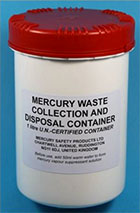Featured
Mercury Spillage Kit Mercury Spillage Kits& Accessories Personal Protection Mercury Waste
Containers Mercury Exposure
Monitoring Consumer Products FREE Downloads
Instructions & Mercury Safety Policies HERE
COSHH regulations say
Wherever mercury is used you must have the equipment to clear up a mercury spillage
Health and Safety
What is mercury toxicity?
Mercury is a dense, silvery metal used in thermometers, pressure gauges such as sphygmos and for some chemical processes. It is poisonous in all its forms - more so than arsenic and cadmium. Usually, the harmful effects of mercury poisoning are seen after exposure to mercury vapour, which is readily given off by the liquid metal; for example, after a spillage or breakage of equipment.
How does mercury enter the body?
Mercury compounds are well absorbed by the body after ingestion, skin exposure and especially via the lungs. It is the efficient absorption of mercury vapour by the lungs while working in a contaminated environment which poses the greatest risk. The World Health Organisation has set a 'safe' maximum working level of 0.05 milligrams per cubic metre - the TLV (time limited value) - to which workers may be exposed for 8 hours per day without risk. But in a poorly ventilated, heavily contaminated room, mercury vapour levels of 400 times the TLV can be reached, putting the occupants at serious risk of toxicity.
What are the symptoms?
Mercury is a non-specific toxin, attacking many of the body's systems. At low levels of exposure, symptoms are mainly related to nerve and brain function and include memory loss, mood instability, tremor and other stress-like symptoms: poor coordination, headache, visual and hearing problems. Recently, reproductive health has been shown to be affected, with abnormalities in menstrual cycle, poor outcome of pregnancy and subfertility in both men and women. The immune system is also damaged by mercury exposure. Adverse health effects in more detail.
Who is at risk?
Occupations involving frequent mercury exposure include dentists, doctors and nurses, laboratory workers in education or in industry. Anywhere mercury thermometers or mercury-containing pressure gauges are used, breakage causes spillage of mercury. Unless such spillages are dealt with quickly and efficiently, contamination of the floor and fabric of the room will continue to produce harmful mercury vapour for years afterwards. In hospitals, breakage of mercury thermometers is very common and has been estimated at two thermometers per bed per year. In an average hospital this represents the accidental spillage and dispersal of kilogram amounts of toxic mercury.
Protection from Mercury Exposure
The chief protection against mercury vapour is the prompt use of mercury spillage procedures. Health and Safety Executive regulations require that anywhere hazardous chemicals - including mercury - are used, a means of controlling spillage and human exposure must be provided. Most Health Authorities expect dental surgeries and GPs to have mercury spillage kits; hospitals, schools and industrial laboratories should also comply under Health and Safety Executive and COSHH (Control of Substances Hazardous to Health) guidelines.
Protection from Existing Contamination
Mercury from previous spillages can be removed by decontamination, using chemical slurries which bind mercury, as part of the regular cleaning routine. Such procedures are recommended for dentists by the British Dental Association, and are equally applicable to the hospital and laboratory.
Monitoring Mercury Exposure
Mercury absorbed into the body is excreted slowly in the urine, with a half-life of some 90 days. Urine levels are therefore relatively constant and will accurately reflect the overall level of mercury exposure, smoothing out day-to-day variations in intake. Monitoring of urine levels is therefore used to identify people who may have been exposed to mercury.
Recommended Reading
- Anderton D (1986) The problem of mercury spillage. Pharmaceutical Journal 237, p 294.
- Anon (1991) The problem of mercury - again. Healthcare Hazards Material Management Oct 1991, p7.
- Blumenthal I (1992) Should we ban the mercury thermometer? Discussion paper. J Royal Soc Medicine 85, p553.
- Choi-Lao A T H et al (1979) Mercury vapour as a contaminant of the hospital environment. Sci Tot Environ. 11, p287.
- Health and Safety Executive (1979) Mercury - medical surveillance. Guidance Note MS12, HMSO, London.
- Hewitt S (1992) Mercury exposure hazards and risk management. A manual for the dental practitioner. ISBN 1- 874692-00-9.
- Wide, C (1986) Mercury Hazards arising from the repair of sphygmomanometers. British Medical Journal 293, p1409.

